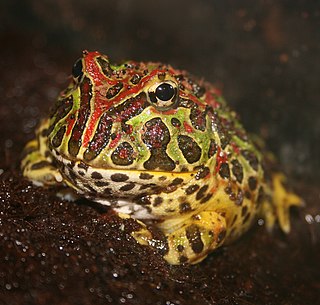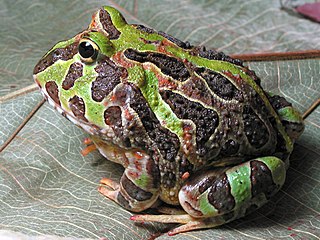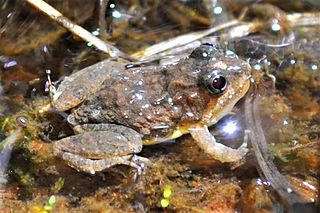
Cranwell's horned frog, also called commonly the Chacoan horned frog, is a terrestrial frog in the family Ceratophryidae. The species is endemic to the dry Gran Chaco region of Argentina, Bolivia, Paraguay and Brazil. It, like other members of its genus, Ceratophrys, is commonly called the Pac-man frog, because of its resemblance to the video game character of the same name. Most adult specimens range from 8–13 cm (3.1–5.1 in) long and can weigh up to 0.5 kg (1.1 lb).

The Argentine horned frog, also known as the Argentine wide-mouthed frog, ornate horned frog, ornate horned toad, ornate pacman frog, or just the pacman frog is a species of frog in the family Ceratophryidae. The species is endemic to South America. It is the most common species of horned frog, in the grasslands of Argentina, Uruguay and Brazil. A voracious eater, it will attempt to swallow anything that moves close to its wide mouth, such as insects, rodents, lizards, and other frogs, even if this predator would suffocate in the process. It is also kept as an exotic pet. The nickname "pacman frog" is a reference to the popular 1980's arcade game Pac-Man, where Pac-Man himself eats quite a lot, and has a mouth that takes up most of its body, much like the Argentine horned frog.

The Surinam horned frog, also known as Amazonian horned frog, is a bulky frog measuring up to 20 centimetres (7.9 in) found in the northern part of South America. It has an exceptionally wide mouth, and has horn-like projections above its eyes. Females lay up to 1,000 eggs at a time, and wrap them around aquatic plants. The frog eats other frogs, fish, lizards, and mice. Tadpoles of the Surinam horned frog attack each other soon after being hatched. This species was once considered the same species as Ceratophrys ornata. This dispute was later settled because the Surinam Horned frog inhabits a different habitat than its smaller cousin and does not interbreed with it in the wild. This species has been known to prey upon the other species of horned frog, especially the northern race of Ceratophrys ornata.

Ceratophrys is a genus of frogs in the family Ceratophryidae. They are also known as South American horned frogs as well as Pacman frogs due to their characteristic round shape and large mouth, reminiscent of the video game character Pac-Man.

The Peru poison frog, also known as Peruvian poison frog, Peruvian poison-arrow frog and emerald poison frog, is a species of frog in the family Dendrobatidae. It is found in eastern Peru and western Brazil. Its natural habitats are primary premontane and subtropical or tropical moist lowland forests, rivers, freshwater marshes, and intermittent freshwater marshes.
Dendropsophus cerradensis is a species of frogs in the family Hylidae.

Dendropsophus elianeae is a species of frog in the family Hylidae. It is found in Brazil and possibly Paraguay. Its natural habitats are moist savanna, subtropical or tropical moist shrubland, freshwater marshes, and intermittent freshwater marshes. It is threatened by habitat loss.
Boana buriti is a species of frog in the family Hylidae endemic to Brazil. Its natural habitats are moist savanna, subtropical or tropical moist shrubland, freshwater marshes, and intermittent freshwater marshes. It is threatened by habitat loss.

The fine-lined tree frog is a species of frog in the family Hylidae endemic to Brazil. Its natural habitats are moist savanna, rivers, freshwater marshes, and intermittent freshwater marshes.

The many-banded tree frog is a species of frog in the family Hylidae found in Brazil, French Guiana, Guyana, Suriname, and Venezuela. Its natural habitats are subtropical or tropical dry forests, subtropical or tropical moist lowland forests, moist savanna, rivers, freshwater lakes, freshwater marshes, pastureland, rural gardens, heavily degraded former forests, and canals and ditches.

The ornate tree frog is a species of frogs in the family Hylidae found in Brazil, Colombia, French Guiana, Guyana, Suriname, and Venezuela. Its natural habitats are subtropical or tropical moist lowland forests, freshwater marshes, and intermittent freshwater marshes.

Ololygon strigilata is a species of frog in the family Hylidae. It is endemic to Brazil. Its natural habitats are rivers, freshwater marshes, and intermittent freshwater marshes.

The Colombian horned frog or Venezuelan horned frog is a species of frog in the family Ceratophryidae. It is found in Colombia and Venezuela. Its natural habitats are dry savanna, subtropical or tropical dry shrubland, subtropical or tropical dry lowland grassland, and intermittent freshwater marshes.
The Caatinga horned frog is a species of frog in the family Ceratophryidae. It is endemic to Brazil. Its natural habitats are dry savanna, subtropical or tropical dry shrubland, subtropical or tropical dry lowland grassland, and intermittent freshwater marshes. They are voracious predators that use a sit-and-wait feeding strategy to ambush prey, which includes ants and small vertebrates. They are also known to be explosive breeders.

The Pacific horned frog, also known as Pacific big-mouthed frog, Stolzmann's horned frog and Ecuadorian horned frog, is a species of frog in the family Ceratophryidae. It is found in Ecuador and Peru. Its natural habitats are subtropical or tropical dry forest, subtropical or tropical dry shrubland, and sandy shores. Its geographical range is very fragmented; it has a total area of about 20,000 km2 and is continuously shrinking due to human activities.
The Ecuadorian horned frog is a species of frog in the family Ceratophryidae. It is endemic to Ecuador. Its natural habitats are subtropical or tropical moist montane forest and intermittent freshwater marshes.
Hydrolaetare dantasi is a species of frog in the family Leptodactylidae. It is only known from the Amazon rainforest of Acre state in western Brazil, although it is likely that it has a wider distribution reaching Bolivia and Peru. Its natural habitats are tropical moist lowland forests, swamps, rivers, freshwater marshes, and intermittent freshwater marshes. It is potentially threatened by habitat loss.

Pseudopaludicola canga is a species of frog in the family Leptodactylidae. It is endemic to Brazil. Its natural habitats are subtropical or tropical seasonally wet or flooded lowland grassland, freshwater marshes, and intermittent freshwater marshes.
Chiasmocleis carvalhoi is a species of frog in the family Microhylidae. It is found in Colombia, Peru, and Brazil. Its natural habitats are subtropical or tropical dry forests or moist lowland forests and intermittent freshwater marshes. It is threatened by habitat loss from farming and logging.

Beelzebufo is a particularly large species of prehistoric frog described in 2008. Common names assigned by the popular media include devil frog, devil toad, and the frog from hell.
















